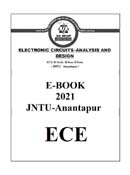

Note: Please check your Spam or Junk folder, in case you didn't receive the email with verification code.
SYLLABUS
UNIT-1
Small Signal Amplifiers Using MOSFETS: Graphical analysis, Load line and small signal parameters, Small signal equivalent circuit, Small signal analysis of Common source, Common drain, Common gate amplifiers, Comparison of the three basic amplifier configurations, Problem solving. JFET Small Signal Amplifiers: Small signal analysis of common source, common drain, common gate amplifiers, JFET as voltage variable resistor, Problem solving. BJT Small Signal Models: Bipolar linear amplifier, Graphical and ac equivalent circuit, Small signal hybrid-p equivalent circuit, Hybrid-p equivalent circuit including the early effect, other small signal parameters and equivalent circuits-h-parameters. Small Signal Analysis: Basic CE amplifier circuit, Circuit with Emitter resistance, ac load line analysis, maximum symmetrical swing, Small signal analysis-input and output impedances, Voltage gain, Current gain of CB, CC amplifiers, Problem solving.
UNIT-2
Frequency Response: Amplifier frequency response-different ranges, short circuit and open circuit time constants, time response, transistor amplifiers with circuit capacitors-coupling capacitor effects, load capacitor effects, Bypass capacitor effects, Problem solving, combined effects of coupling and bypass capacitor, high-frequency response model for BJT and MOSFETs, short circuit current gain, Miller effect and its applications, unity-gain bandwidth in BJT and FET amplifiers, CE and CS circuits, CB and CG circuits, Cascode amplifier analysis, emitter and source follower circuits, high frequency response- design application.
UNIT-3
Differential and Multistage Amplifiers: Differential amplifier, basic BJT differential pair and its qualitative description, DC transfer characteristics, small signal equivalent circuit analysis, CMRR, differential and common mode gains, differential and common mode input impedances. Basic differential FET pair, small signal equivalent circuit analysis, JFET differential amplifier, differential amplifier with active load, MOSFET differential amplifier with active load, two stage RC coupled amplifier, Darlington pair and simple emitter follower output, voltage gain, input and output impedances, simplified BJT operational amplifier circuit, design applications - CMOS differential amplifier.
UNIT-4
Feedback Amplifiers: General Considerations, Properties of Negative Feedback, Types of Amplifiers, Sense and Return Techniques, Polarity of Feedback , Feedback Topologies, Effect of Nonideal I/O Impedances, Stability in Feedback Systems , Analysis of a feedback Amplifiers - Voltage – Series, Current Series, Current-shunt and Voltageshunt , Illustrative problems. Oscillators: General Considerations, LC Oscillators, Phase Shift Oscillator, Wien-Bridge Oscillator, Crystal Oscillators, Illustrative Problems.
UNIT-5
Power Amplifiers: Classes of amplifiers-Operations of Class A, B, AB, C, class-A: Inductively coupled amplifier, transformer-coupled common emitter amplifier, transformer-coupled emitter-follower amplifier, Class-AB Push-pull complementary output stages-class-AB output stage with diode biasing, class-AB biasing using the VBE multiplier, class-AB output stage with input buffer transistors, class –AB output stage utilizing the Darlington configuration, Illustrative Problems. Tuned Amplifiers: Introduction to tuned amplifiers, Role of Q-Factor, Single-tuned, Doubletuned and Staggertuned amplifiers.
 No Preview is available for this book
No Preview is available for this book

 Get 100 instant uPoints on the purchase of Rs.100 or above for each order.
Get 100 instant uPoints on the purchase of Rs.100 or above for each order.
CategoriesElectronics & Communication

Format PDF

TypeeBook